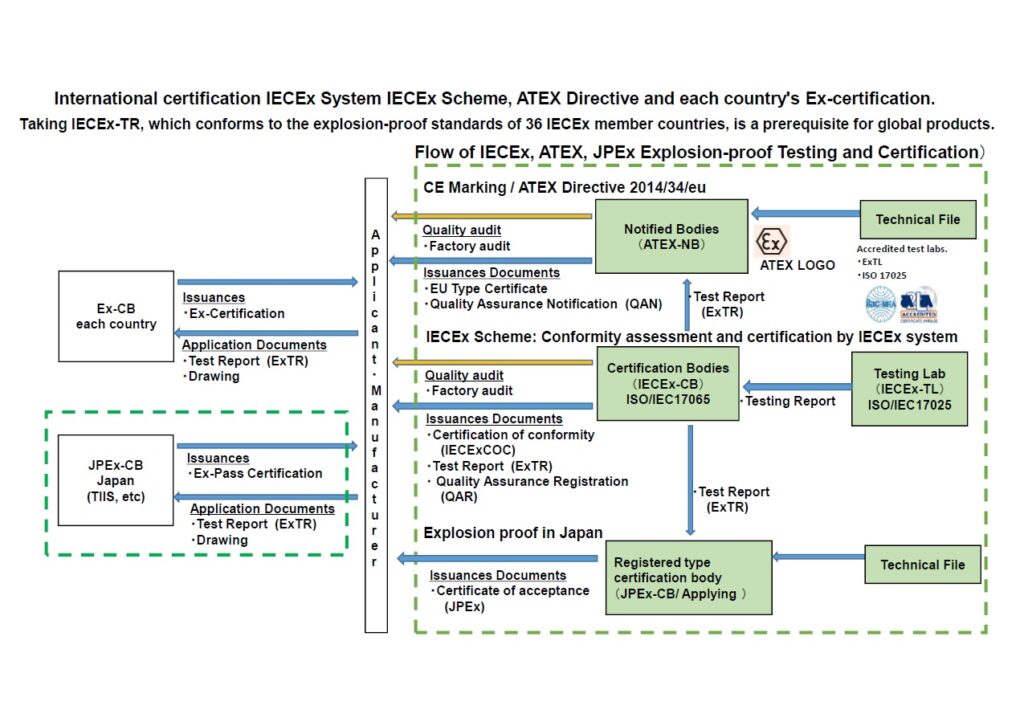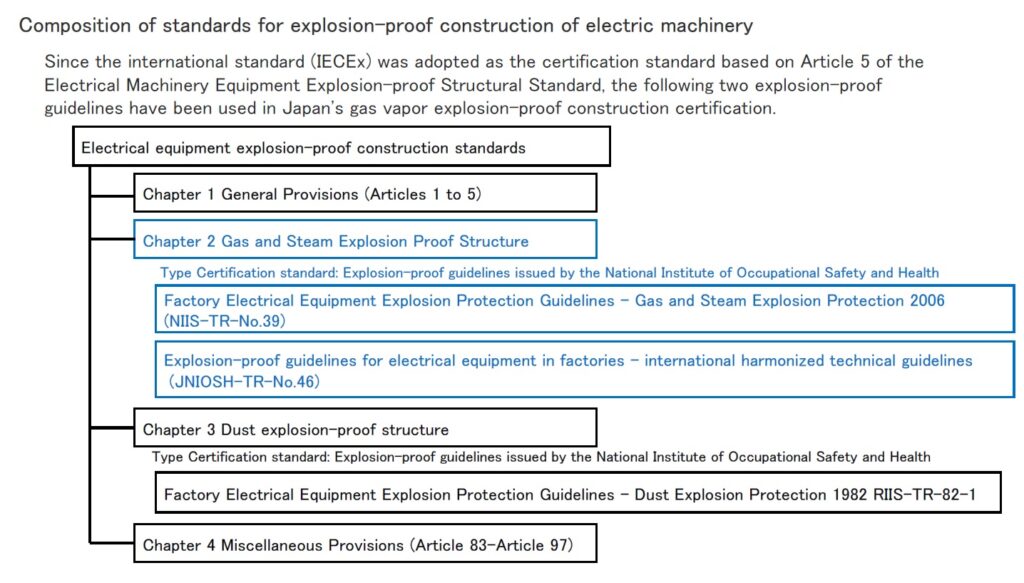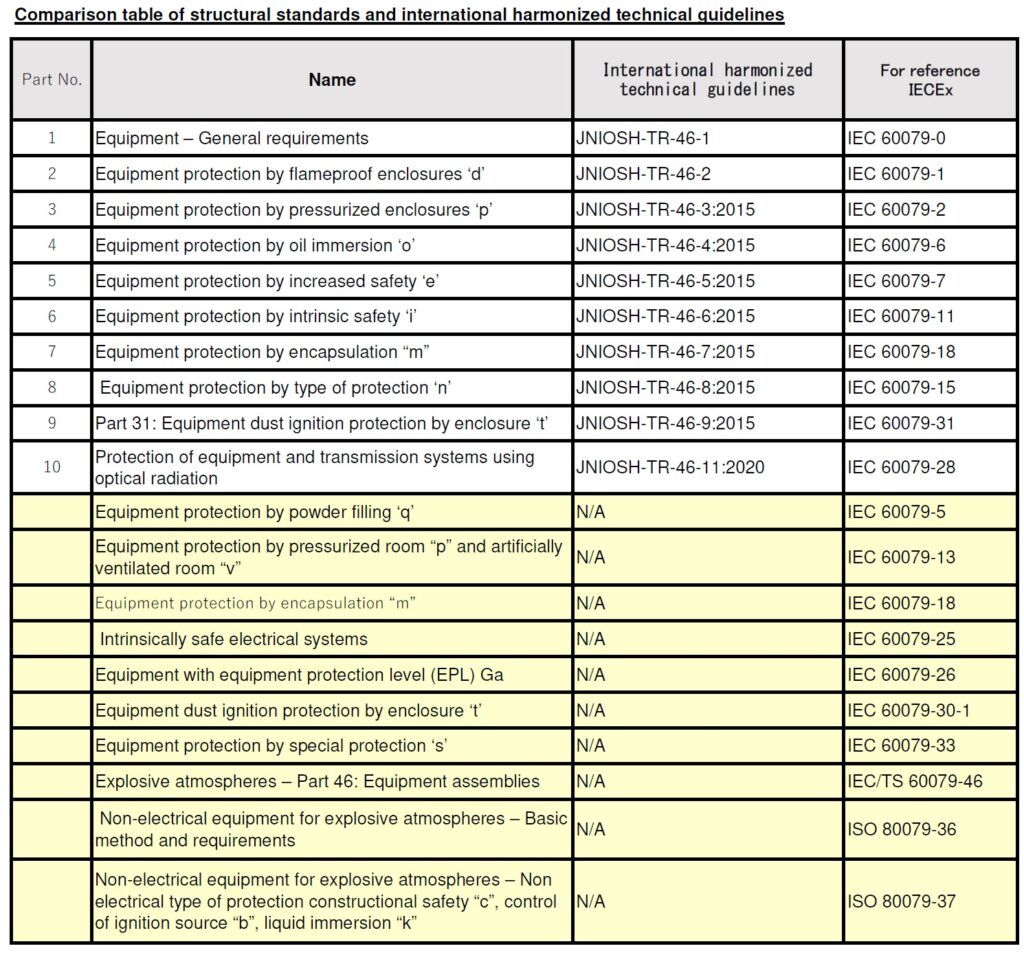TIIS/JPEx, IECEx, ATEX
- Application and acquisition of Japanese explosion proof TIIS’s certification “JPEx” for expored products
We provide support (consulting) to exporters and/or importers who are selling imported products in Japan. If your equipment is certified by IECEx, you can skip the test and simply check the application documents (if there are no major problems) to more easily obtain a Japanese explosion proof certification and enter the Japanese market. This will significantly reduce the number of man-hours, time and costs required to enter the Japanese market. - ATEX, IECEx explosion proof certification application and acquisition support and provision of technical support
KSC JAPAN works with our partners ATEX-NB/IECEx-ExCB/ExTL to provide solutions and support for the introduction of your components, equipment and systems into the EU and global markets. In order for our customers to securely obtain certification, we provide the necessary explosion-proof expertise (techniques), prepare application documents, and provide support (consulting) on application methods, etc. - Your global partner
The third-party certification bodies that KSC JAPAN is affiliated with are Type A ATEX Directive certification bodies and IECEx-approved certification bodies. We are your partner in certifying equipment for use in hazardous locations with potentially explosive atmospheres. We provide certification and services for explosion-proof equipment and protection systems in compliance with European and international regulations such as ATEX Directive 2014/34/EU and IECEx scheme.
“JPEx”: Japan Explosion Proof to be instead of former TIIS.
JPEx, JAPAN Explosion Proof, IECEx and QAR
representative application and consulting services
Apply to TIIS, Technology Institution of Industrial Safety
TIIS’s explosion-proof related business content below
・Japan explosion-proof application: Submit the application documents along with a document stating the results of the tests conducted in advance.
・IECEx application: Apply by attaching drawings and technical documents that comply with IECEx OD 017.
・QAR application (for QAN, issuance is outsourced to an external organization): Submit a quality control manual (quality management system manual) that complies with the requirements of ISO/IEC 80079-34 and ISO 9001.
KSC JAPAN provide
the application for Japan Explosion Proof Certification
using IECEx application agency and consulting services.
The applicant must submit a test result report issued by the IECEx Certification Body (ExCB) (or the ATEX Certification Body (NB) issued as the NB if the ATEX Certification Body (NB) also serves as the ExCB) in the application form for new type certification of Japan Explosion Proof (JPEx) equipment. If a test result report (test result report) is attached, the report will be treated as a “document containing the results of a previously conducted test.”
However, the following items 1 to 4 must be confirmed.
- The test result report shall be for the type for which the application was made.
- The test result report must be properly issued in accordance with the ATEX Directive.
- The contents of the test result report must cover the contents of the test report (ExTR) properly issued based on the IEC Explosion-proof Equipment Standards Conformity Certification System (IECEx).
- The test result report must be written in Japanese or English or have Japanese or English attached.
DOWNLOAD below documents issued by Ministry of Health, Labour and Welfare.
Kianhatsu Issue 0305 No. 2 “Procedures for application for new type certification for explosion-proof electrical equipment” issued by Ministry of Health, Labour and Welfare.
Kianhatsu Issue 00106 No. 2 “Procedures for application for new type certification for explosion-proof electrical equipment” issued by Ministry of Health, Labour and Welfare.
Access to the global market
The certification issued by ATEX & IECEx contributes to expanding the market for explosion-proof products to the world.
・EU, international market: ATEX certification
・Country-specific standards: IECEx certification-> JPEx & each country’s certification
Increased safety and reduced risk enable innovative design and manufacturing. Obtaining certification is one option to show the high quality of the product. With one-stop service proposed by KSC JAPAN, we can beat today’s society and accelerate the global expansion of our products.
Taking IECEx-TR, which conforms to the explosion-proof standards of 36 IECEx member countries, is a prerequisite for global products.



KSC JAPAN’s one-stop service
・For domestic products, it is possible to obtain IECEx & ATEX at the same time by applying for Japan Explosion Protection (JPEx) in the internationally harmonized technical guidelines.
・For overseas products, by attaching ExTR at application, it is possible to apply for Japanese explosion protection without testing with the actual machine.
・For other overseas explosion-proof applications, please contact us.
Basic matters concerning “explosion-proof electrical equipment”
Regulation by law
·Industrial Safety and Health Act
・Occupational Safety and Health Enforcement Order
・Electrical Machinery Explosion-proof Structural Standards (Ministry of Labor Notification No. 16, 1969)
・Ordinance for Examination of Machines, etc. (Ministry of Labor Ordinance No. 45, 1972)
Configuration of explosion-proof construction standards for electric machinery
Based on Article 5 of the explosion-proof structure standards for electrical machinery and equipment, the international standard (IECEx) has been adopted as the standard for certification. And the following two explosion-proof guidelines are used in the certification of gas vapor explosion-proof structures in Japan.


Based on the fact that the IECEx Equipment Certification Scheme stipulates that a new type approval shall be issued for the current edition or the previous edition (one previous edition) of the standard, the same shall apply to the Internationally Harmonized Technical Guidelines.
When applying for internationally harmonized technical guidelines using ExTR
Excerpt from “KIHATSU” issued by the Labor Standards Bureau, Ministry of Health, Labor and Welfare.
Application with ExTR attached to the application form: Article 6, Paragraph 1, Item 4 of the Appraisal Regulations “Document stating the results of tests conducted in advance on the type of machine, etc.”
ExTR issued by ExCB under IECEx (with the date of issuance within the valid period of ExCB certification) is attached, and if the following requirements (1) and (2) are confirmed, the report shall be submitted as a It may be treated as a “document stating the results of tests conducted in advance regarding If there is an error or unclear part in the ExTR, the relevant part shall be inspected using the actual equipment.
(1) The attached ExTR must be for the model for which the application was made.
(2) The attached ExTR must be properly issued by ExCB based on IECEx.
Article 6. Attempting to receive a new application (hereinafter referred to as “new certification”) for the certification pursuant to the provisions of Article 44-2, paragraph 1 or 2 of the Act (hereinafter referred to as “type certification”) In this case, the person who conducts the type examination by attaching the following drawings and documents to the new examination application form (Form No. 6) for each type for which the new examination is to be performed (hereinafter referred to as the “type examination operator”). ) must be submitted to
1. Structural drawing of the machine, etc. of the relevant type and, in the case of a machine, etc. with electrical circuits, the relevant circuit diagram
2. Instructions on the performance of the machine, etc. and instructions on how to handle the machine, etc.
3 Document stating the following items related to the machine, etc.
a) Outline of the equipment that manufactures and inspects the machine, etc.
b) Person in charge of working on the machine, etc.
c) Inspection organization for the machine, etc.
d) Regulations for inspection of the machine, etc.
4. A document stating the results of tests conducted in advance on the machine of the model concerned
5. For machines, etc. listed in Article 14-2, item 8 of the Cabinet Order, a specification in Form 7
Equipment protection level (EPL): The equipment protection level (hereinafter referred to as “EPL”), which indicates the degree to which explosion-proof equipment does not become an ignition source or an ignition source, including when it is malfunctioning. It was introduced from the International Harmonized Explosion Protection Guidelines 2015.
Handling of Ex components, etc.:
a) Ex components, Ex cable glands, Ex screw adapters, and Ex closing parts (hereinafter referred to as “Ex components, etc.”) are not subject to the type examination based on the law as individual units, but they are explosion-proof. It is necessary to maintain the explosion-proof structure of the equipment and is used by being incorporated into the explosion-proof equipment.
b) In the case where a registered type examination body conducts an examination according to the Internationally Harmonized Explosion Protection Guideline 2020, the said type examination body shall provide certificates, etc. related to Ex components, etc. is issued, and if you have drawings, test data, etc. related to the Ex-component, etc., you may use them for testing until the certificate, etc. expires.
Here, certificates, etc. related to Ex components, etc. are limited to those based on the same standards as the International Harmonized Explosion Protection Guidelines 2020.
Routine test: The “routine test” newly included in the Internationally Harmonized Explosion-Proof Guidelines 2015 requires that when applying for a new test, the machine, etc. test regulations (1972 Ministry of Labor Ordinance No. 45; Article 6 The type approval agency shall confirm the type of test, implementation method, etc. based on the document submitted by the applicant based on the provisions of paragraph 1, item 3, d). In addition, the same shall apply to renewal certification based on the provisions of Article 11 of the Certification Regulations.
Scope of electrical equipment to which Article 280 of the Safety and Health Regulations does not apply (simple equipment)
According to IEC standards, electrical equipment whose maximum rated voltage, etc. Even if it is used in a place where dangerous concentrations may be reached, it must not become an ignition source or a source of ignition, and Articles 280 to 282 of the Industrial Safety and Health Regulations shall not apply. However, this shall not apply when there is a risk that the rated voltage, etc. of the circuit of the electrical equipment may exceed the value of each category in the following table by connecting the electrical equipment to other electrical equipment.
・Rated voltage: 1.5 volts (1.2 V in International Harmonized Technical Guidelines 2008)
・Rated current: 0.1 amperes
・Rated power: 25 milliwatts
・Passive components (switches, resistors, etc.)
・Energy storage sources (equipment including capacitors, inductors, etc.)
・Energy source (thermocouple, photocell, etc.)
Inverter motor: Flame-proof motors cannot be used unless they have passed the “explosion-proof test” in a one-to-one combination with an inverter by law. The use of inverters approved for combination by explosion proof certification is obligatory. It is obligatory to indicate on the combination nameplate the combination that has passed the “explosion proof test” in a one-to-one combination with the inverter. Moters of “type of protection “n” electrical apparatus” are not permitted to be combined with inverters.
Electric heater: An application that maintains explosion-proof performance for the entire system, including the interlock circuit and temperature control, is required.
Overview of manufacturing inspection equipment, etc.: Foreign products must meet the manufacturer’s qualification requirements (Article 6, Paragraph 1, Item 3 of the Appraisal Regulations) with a certificate of conformity (IECExCoC) issued by a certification body (ExCB). I assume.
Article 6, Paragraph 1, Item 3 of the Appraisal Rules
3. A document stating the following items related to the machine, etc.
A. Outline of the equipment that manufactures and inspects the machine, etc.
B. The person in charge of the work of the machine, etc.
C. Inspection organization for the machine, etc.
D. Regulations for inspection of the machine, etc.
Note that Factory audits are not required in Japan’s explosion-proof certification system. You will submit a summary of manufacturing inspection equipment at the time of application and at the time of renewal, and we will examine the documents.
Test/Evaluation: Japan’s certification system allows manufacturers to confirm the suitability of designs and conduct evaluation tests (first-party certification/In-house certification). It is possible to submit this report to the certification body as “results of tests conducted in advance”. The submitted “preliminary test results” and the test (verification test) conducted by the certification body are evaluated, and if conformity to the standard is confirmed, the certification body issues a type approval certificate.
Fast Track Process: IECEx have a rule below.
“ExCB organizations accept ExTRs issued by foreign ExCBs, conduct additional tests and evaluations for parts that do not comply with their own standards, and issue a certificate of conformity that are valid in their own country.”











